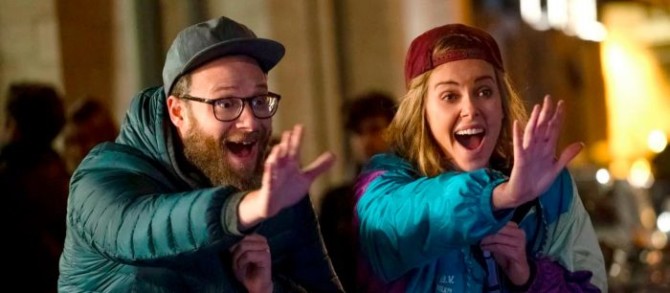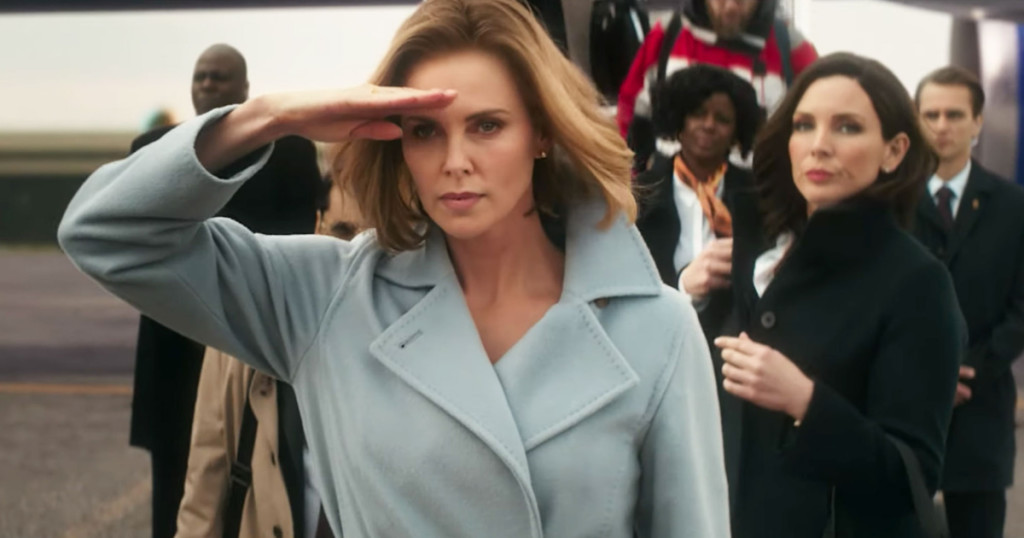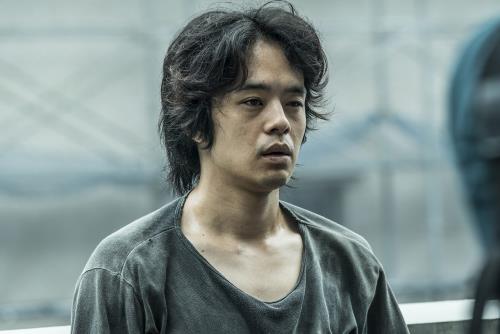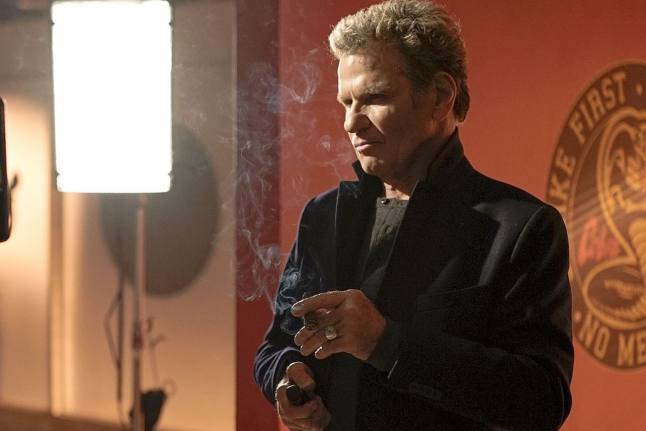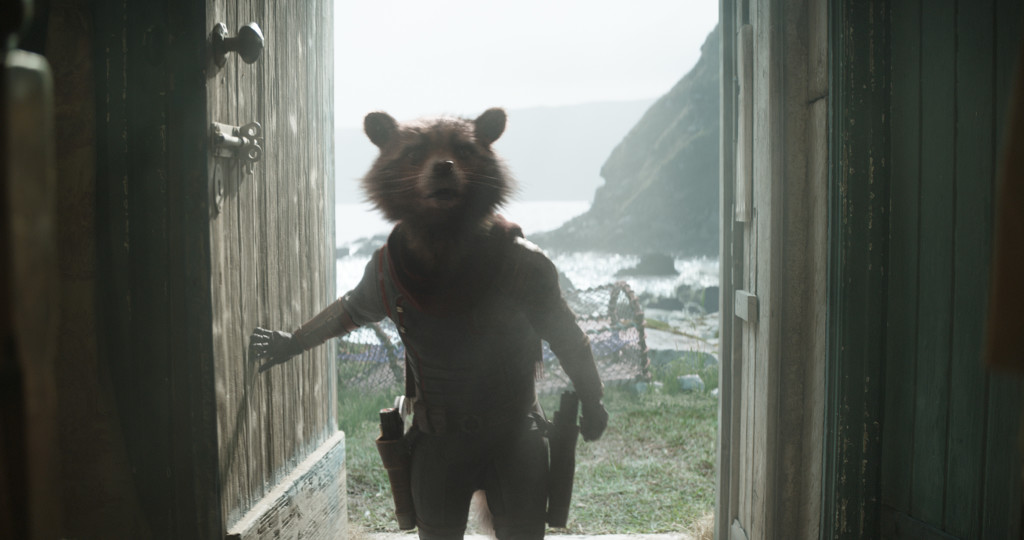Genre: Romantic Comedy
Premise: A schlubby political writer is scooped up by the Secretary Of State to help write speeches for her presidential run.
About: This script made the Black List – count with me now – EIGHT years ago. Never say die in this business, right? Dan Sterling, the script’s original writer, has written on The Office, King of the Hill, and South Park. Liz Hannah (The Post) came in to, presumably, add some authenticity and believability to Charlotte’s character. And then, of course, Seth Rogen’s uncredited gang of punch-up writers came in to add a lot of jokes, which I’ll be discussing in the review. Jonathan Levine, who’s worked with Rogen before on 50/50, directed the film.
Writer: Dan Sterling and Liz Hannah
Details: 2 hours long
Before we get started, can we all take a second to appreciate how hard it is to make a good comedy? I mean, how many truly funny comedies have there been since the beginning of the century? Five maybe? If that? That’s one every four years. I came into this screenwriting adventure thinking comedy was the easiest genre. I now believe it to be the hardest.
The Long Shot took that handicap, shoved all its chips in, and said, “I’ll raise you another handicap.” They added politics to the mix. Yeah, because politics in 2019 isn’t polarizing at all. I actually think The Long Shot did a pretty good job handling its political plotline. But here’s the final word on The Long Shot. The movie is a couple of inches shy of being really good. And, unfortunately, those couple of inches are the difference between a comedy blowing up and fading away. I mean it was RIGHT THERE. What happened?
Charlotte is the Secretary of State and one of the top Democrat hopefuls to take the office of the presidency in 2024. But when the current president, unexpectedly, decides he’s not running for re-election, Charlotte decides to take a shot (a long shot) at being the U.S.’s first female president in 2020.
There’s a small problem. Charlotte’s numbers show that she’s not funny. She needs someone to help punch up her speeches with some humor. Enter Fred Flarsky, a dopey glorified blogger who writes scathing articles on big business. While these articles are a bit… aggressive, they’re also funny. And here’s the thing – Charlotte actually knows Flarsky. She babysat for him when he was a kid. So when the two bump into each other at a fund-raising event, it’s a natural fit.
Charlotte’s team hates Flarsky. He looks like one of those old multi-colored umbrellas wrapped around a potato. And outside of his writing, he’s kinda clueless. But Charlotte likes him. And as the two work together on her big environmental pitch, a romance blossoms. There’s only one problem. Everyone knows that the optics of this perfect specimen of a human being known as Charlotte being with Flarsky aren’t ideal. Which means, sadly, their relationship is doomed.
This movie does so much right! We’ve got a super-clear high-stakes goal driving the plot – Charlotte’s bid for presidency. We’ve got two characters who we want to be together but have several levels of conflict getting in the way. We’ve got lots of great dialogue. All of the characters except for a few minor exceptions are funny. O’Shea Jackson Jr. is a movie star in the making. What I could do with just an ounce of his charm. And on top of that, all of the romance works, which is the hardest part in these movies! Theron and Rogen, surprisingly, have amazing chemistry.
And like I said, it makes for a good movie.
But then why isn’t it a GREAT movie? What’s holding it back?
For starters, Rogen’s joke people need to step the f*&% off. For crying out loud. You had a good script as is. Then Rogen’s people came in and added 50+ s&*%, p&*%, vomit, b*&^er, and bodily fluid jokes. I mean, seriously? I get it if you’re making Pineapple Express, The Extended Edition. But this is a political romantic comedy. Why is there a scene where Charlize Theron explains that she once had to s&%* in her purse during a meeting? Why is the CLIMAX of the movie, no pun intended, Seth Rogen jacking off into his own face? Seriously? That’s how you’re going to end your movie?
And here’s the real problem. When they test these jokes on audiences, people WILL LAUGH. That’s because they’re obligatory laugh jokes. People laugh at the outrageousness of them even though they don’t actually find them funny. However, Rogen’s team can point out that people DID laugh and therefore the jokes should stay. Again, I have no issues with this humor when it’s appropriate. A bodily fluid joke makes sense in a movie like The 40 Year Old Virgin, which is about a man who’s never used his bodily fluids. It makes zero sense here. This should’ve been a sweet political romantic comedy. Instead, they raunchified it, confusing the tone.
Then we had seemingly small miscues that had much bigger ramifications than the filmmakers realized. One of the major plot machinations was that Charlotte’s “humor” number was down. That was the only thing out of all of her traits the public didn’t like. But here’s the weird thing. The number was still high. She had, like, an 89 out of 100. It just wasn’t *as high* as the other numbers. The reason this is a big deal is because the ENTIRE MOVIE is built on her needing a comedy writer to make her funnier! So why are they giving her a B+ level of humor?? In comedy movies, you work with extremes. Subtle doesn’t fly. Make her comedy number a 65 so that SHE ACTUALLY NEEDS HELP. Otherwise, there’s no need to have Flarsky in the movie.
Sadly, we have yet another case of over-development. I get that this script was ten years old. But the only thing you should’ve had to update was the political stuff. They shouldn’t have messed with everything else and they ESPECIALLY shouldn’t have stuffed in a bunch of lowest common denominator jokes. These guys are comedy veterans. They should know by now that different comedies require different types of humor.
I have one last thought. I remember there was this old belief, when movie stars didn’t do TV, that went something like this: “Why would they pay for you at a theater if they can get you at home for free?” It sounded good but there wasn’t any real way to prove or disprove the hypothesis since there weren’t enough people crossing over to a study on. But then the Franchinizing happened, and movie stars were forced into television. And I think I can finally say that when there aren’t any special effects or big concepts in a movie – when the film is just about the actors, as is the case with The Long Shot – it doesn’t feel special anymore. You’re sitting there watching the movie and saying, “Was this really worth 20 bucks?” The answer, unfortunately, is no.
But I have a feeling this is going to become a huge hit on digital. Had it debuted on Netflix, it would’ve been their best romantic comedy ever, and probably would’ve gotten a lot more fanfare. It’s a good movie. It really is. It just never gets over that “great” hump.
[ ] What the hell did I just watch?
[ ] wasn’t for me
[x] worth the stream (when it comes to digital)
[ ] impressive
[ ] genius
What I learned: I’m going to steal from myself and use my original Flarsky ‘what I learned’ tip – “The impossible choice. Force one of your leads into an impossible choice at the end of the movie. Here, Charlotte must choose between her career and Flarsky. If you set that decision up well (where each choice has devastating consequences), we’ll be dying to know what they choose.” I’d add to this that when you’re writing a character piece, the “impossible choice” is really the only way to end your movie. You don’t have a big action set piece to do the heavy lifting. It’s all character. And there’s nothing more compelling than one of your characters being forced to decide between two things that they desperately want.
Genre: Period Drama/Supernatural
Premise: During World War II, a family imprisoned in a Japanese-American internment camp must prevent a violent ghost from worsening relations between their fellow internees and the camp’s administration
Why You Should Read: In The Sun Ghost, I’ve tried to use the tools of fantasy and horror to explore issues of loyalty, intergenerational trauma, and Asian-American identity in an under-depicted World War II setting. While I hope horror aficionados will appreciate the twists put on familiar monster rules and fans of Del Toro’s dark fairy tales will find something to enjoy, I also think that general audiences will find it sadly relevant to current events. Based on its performance in contests and the Black List website, I want to believe the script has potential. I’m looking for sharp eyes and sharp minds to help me take it to the next level.
Writer: Arun Croll
Details: 117 pages
As some of you know, I started reading this script last Thursday, got about 30 pages in, and decided I wasn’t giving it my full attention. Now if I’d sensed that the writer hadn’t given the script their all, I might’ve kept going. But Arun clearly put his blood, sweat, and tears into this. What I read was deeply researched, heavily detailed, and professionally presented. So I saved it for this week, when I’d have more time.
While I enjoyed what I’d read, one thing was nagging me. This is essentially a dual-concept script (one story is about trying to survive in a Japanese-American Relocation Center, the other about a shadow ghost) and I wasn’t convinced that these two worlds could co-exist. But I hadn’t made up my mind yet. I was ready to be persuaded. Would Arun succeed in doing this? Let’s find out.
The year is 1944. We’re in a Japanese-American relocation center. 29 year-old Kosuke Nagata, a dutiful worker who jumps whenever the Americans say “jump,” is married to Sarah, a young beauty who sells self-made sake and sleeps with other men. Sarah thinks her husband is weak and doesn’t respect him.
Kosuke’s 31 year-old sister, Akane, works at the center’s newspaper, and is always trying to get her boss to print riskier articles, things that question the practices of the Americans. Well she’s going to get her story all right. When Sarah’s drunk father tries to escape, an officer threatens and then starts shooting at him. As this is happening, a mysterious force grabs him from behind and chokes him. The officer barely survives, and when he turns around, there’s no one there.
It turns out Kosuke has a secret. A warrior ghost named “Ume” follows him around, and does the bidding of Kosuke’s heart. If someone starts messing with Kosuke or someone Kosuke loves, the ghost will attack that person. This doesn’t bode well for Sarah’s lovers. Indeed, her friends with benefits pal, Ikko, is murdered by Ume. Of course, as both the American and Japanese communities look into the officer attack and Ikko’s murder, no one thinks to include, “Ghost Shadow Man” as a suspect.
Finally, Kosuke comes clean, telling his American boss and his wife that he has a killer ghost who shadows him around. They don’t believe him, so Kosuke takes care of the problem on his own, decapitating Ume out in the fields. Unfortunately, Ume reemerges, this time attaching himself to Kosuke’s 6-year old daughter, Mimi. When the American captain finds evidence that Ume exists, he becomes obsessed with delivering Mimi to doctors and having her studied as a potential weapon. It will be up to Kosuke to make sure that doesn’t happen.
My brother was having trouble deciding on a new car to buy and I mentioned to him, “Why not go with a Mazda 3?” He gave me a stern look, as if I had just made the world’s dumbest suggestion. “You don’t like the Mazda 3?” I asked, a little scared. “I don’t like cars that can’t decide what they are. Is it a sedan or a sports car? Pick a lane.” This is the same way I feel about almost-horror films, movies where horror is present, but isn’t the main storyline. Or maybe it is but the rest of the story is different enough that you’re never sure what you’re supposed to be focused on.
You’ve got two unique elements here. One is the mythology of the relocation center. The other is this cool ghost creature. It’s not that there isn’t some crossover between the two. I’m just not sure there’s enough to garner a cohesive experience. You could’ve easily built a drama around the relocation center and had a good movie. So then you have to ask, why bring in the other element?
That’s a question I was still asking an hour after I finished the script. What was the point of this ghost storyline? When it comes to Kosuke, he seems to be a wimp. He does what the “man” tells him to do. Ume, meanwhile, doesn’t take crap from anyone. When he gets mad at somebody, he goes after them. The problem is that this contrast didn’t play out in any thematically coherent way. I didn’t get the sense that Ume represented Kosuke’s alter ego, in which case you could’ve made this a character study. His targets weren’t methodically thought out. They happened whenever Kosuke was nearby a situation that went bad. What’s the message there?
And I definitely didn’t understand the bigger thematic picture. I have no idea what this movie is trying to say about relocation centers in World War 2 other than, “They’re sort of bad.” And that’s another thing. The “bad guys,” aka, the American soldiers, were never that bad. The majority of them didn’t like that they were imprisoning the Japanese. So you didn’t have any clear targets to take down. This contributed to the randomness of the narrative. I don’t know what this is saying about Kosuke. I don’t know what this is saying about the camps. And then once the daughter gets the ghost, all bets were off. I had no idea how I was supposed to interpret that.
To be honest, I don’t even know if I should be trying to make sense of this. But whenever you build a story around something as serious as World War 2, you usually want a strong theme to shine through. It does’t have to be complex. I remember the Academy Award winning “Life is Beautiful.” That movie was very simple. It was about protecting your child from the horrors of war at all costs. I don’t know if Arun is trying to be too clever here or too subtle, but maybe if he shared the theme in the comments, I could better explain how to get there with the story.
Then again, these scripts are always the most troublesome to me – the ones where you’ve got two big ideas competing for the same story real estate. And by that I mean, each idea could carry its own movie. You could make a movie about Japanese-American camps without ghosts. And you could make a movie about this ghost without the camp. I actually think the ghost is really cool. He’s this ancient warrior who latches onto people and attacks those who hurt them. I could see that taking place in a small town. I don’t know why we need this big complex canvas for it.
But I’m sure Arun would argue that then the idea isn’t big enough. And maybe he’s right. I don’t know. All I know is that when I finished this script, I was confused. I was confused what the story was ultimately about. I was confused what I was supposed to feel afterwards. And I was confused what the message was. I suspect it’s a “two competing stories” problem but maybe I just don’t like this type of movie. I wasn’t a fan of that similar del Toro film, “The Devil’s Backbone,” either. I thought it had the same problems. What did you guys think?
Script link: The Sun Ghost
[ ] What the hell did I just read?
[x] wasn’t for me
[ ] worth the read
[ ] impressive
[ ] genius
What I learned: Theme becomes more important the more dramatic your story is. Nobody walks out of John Wick raving about the message. But for something like “The Imitation Game,” they want to leave feeling a little wiser about the world. A clear theme will achieve that.
Doubt is an awful thing. It affects many areas of life. The worst part about doubt is that it fuels inactivity. The more you doubt, the less you do. Nobody knows this more than writers. And what exponentially sucks is that the more writing knowledge you accumulate, the more doubt you have. While this may seem counterintuitive, it’s not as illogical as you’d think. When you start out, you assume everything you write is great. This makes writing easy and fun. As you get older, however, and receive more feedback, you realize that a) you’re not as good as you thought you were and b) the craft is much harder than you thought it was. This makes you more critical. You become more aware when you’re writing badly. The realization that you can write badly is what begins the doubt train. In addition to this, you’ve experienced rejection – industry people ignoring you, not calling you back, ghosting you. That takes its toll. You realize your writing has to be amazing to prevent these things from happening. And the more you study screenwriting, the more you know how difficult it is to write something amazing.
It’s also hard to measure your progress in writing. If you’re a tennis player, you can have your serve radared to see how many more miles per hour you’re adding each year. Your rallies are lasting longer. You’re beating more opponents in tournaments. If you’re a bodybuilder, you can literally see the changes in your body in the mirror. Conversely, it’s incredibly difficult to measure progress as a screenwriter. You have contests. But there’s such a level of subjectivity when it comes to them that it’s hard to trust them. This lack of clarity on where you stand ramps up the doubt in your head.
Then, as you get older, a new pressure surfaces. “Time is running out,” you think. You’re not 24 anymore where you could spit out two practice scripts and not worry that they’ll never see the light of day. Each script has to count. This means it needs to be perfect. That perfectionism will only fuel more doubt. Can I do it? Am I able to write something great? It’s harder to sit down and write a scene when you’re doubting whether it can reach the lofty goals you have for it. And then there are the obvious things such as increased responsibilities. A spouse, children, a real job, paying the mortgage. All of that stuff takes up time, which gives you less time to write, which puts even more pressure on you when you do write.
All of these things combine to create an atom bomb of doubt. But unlike a traditional bomb, this one is suspended over you permanently. The bomb is always going off, always preventing you from sitting down and writing. And that’s the goal here. All I want you to do is WRITE. I don’t want you to worry about what will happen when you write. I don’t want you to worry about what will happen after you write. When doubt is a part of your everyday existence, all that matters is the present. Get in there and write. With that in mind, here are six strategies to stave off the doubt and keep you churning out pages.
Make Writing a Habit – The best way to curb doubt is to create a schedule that doesn’t allow it to enter into the equation in the first place. And you do this by scheduling in a time to write every day. It’s sort of like dieting. If you don’t have your meals picked out and ready for the day, there’s more of a chance you’ll crack and go eat something you’re not supposed to. Habit erases that evil part of your mind that wants to sabotage you. If you don’t have a schedule, you give doubt an opportunity to chirp away until it’s won.
Don’t Think, Just Write – Doubt is a voice. That’s all it is. It’s a voice inside of you who’s trying to make a point. And unfortunately, that point is a negative one. The less you’re doing, the more you allow that voice to make its argument. And so the best thing to do is just write. Don’t think about if you should write or what you’re going to write or why you thought this idea was good or not. Just get in there and start writing. I’ve found that once you start writing, you’ll keep writing. So stop thinking and start writing.
Write Whenever You’re Inspired – Make this a rule from now on. Inspiration is the greatest thing in the world. And the longer you do something, the less inspiration comes around. So make a deal with yourself. No matter what you’re doing – even if it’s the middle of a romantic love-making session – if you’re inspired, stop and write. Because you don’t know when that inspiration is going to come again. No pun intended.
Trick Yourself – I don’t love this technique. But we’re not trying to win style points here. As long as you’re writing, you’re winning. So if you’re really having trouble putting pen to paper, try this. First, tell yourself you’re not writing. I’m serious. For this to work, you have to trick your mind into believing that it doesn’t have to write. That way, all the pressure will be released. Then, go into your outline (or your script notes document) and look through it. Again, keep telling yourself you’re not writing today. Usually, however, you’ll come across a note or a scenario that makes you want to jump into your script and tweak something. The next thing you know, you’re in your script writing! And when you’re finished with that scene, why not keep going!? Another technique you can use is to proofread the last 1-3 scenes you wrote. Again, tell yourself you’re not writing. Just proofreading. However, once you’re actually in the document, there’s a much better chance you’ll start writing. It’s a very weird way to solve the problem, but when you think about it, your mind doing everything in its power to keep you from writing is also weird.
Write Any Scene – Don’t think that you have to write linearly. That’s a recipe for stagnation. And stagnation will lead to doubt which will keep you from writing. If you’re stuck in your script but you have a good idea for a later scene? Go write that later scene. Again, if you’re writing, you’re winning. If you’re hovering or thinking, you’re allowing doubt to creep in. I’m not saying to never analyze your choices. But there’s a time and place for that. If you’re struggling to put pen to paper, don’t use the excuse that you need to think through it first. That’s the Doubt Monster manipulating you so you don’t have to write. Only when you’re in a healthy writing place do you want to pull away and think about the script as a whole. When you’re struggling, you need to be writing.
Write Anything – If your doubt is through the roof and you’re really having trouble getting in there and writing your script, go write ANYTHING else. A short script. Dialogue practice. Anything. One thing I used to do is go to a random image generator site, find an image, and use it as inspiration to write a short script. This will get you in the writing mindset and remind you that writing can still be fun. This increases the chances that you’ll get in there and write some scenes in your current script. I’ll finish this off with an inspiring story. There’s a writer I know who was really struggling with the things I talk about in this article. He was going on 6-7 years and not having a lot of success. And I’ll be completely honest. I wasn’t a huge fan of his work. But then he sent me something not long ago and it wasn’t just good. It was really good. I asked what he did. What did he change? And he said that he was just messing around on screenwriting sites and one of them had a few of those scene challenge prompts. I don’t remember what the prompt was. It was something to the effect of, a dialogue scene between two characters in a room with lots of conflict. Anyway, he enjoyed writing the scene so much that he expanded the idea into a feature. And it was bar none his best script. And it all happened because he sat down and started writing. When you’re consumed with doubt, all you should focus on is getting in there and writing. Cause who knows what will happen. It might lead to something great, like it did for this writer.
Genre: TV – Drama
Premise: When former Cobra Kai boss John Kreese moves back into town, he challenges Johnny to take his students to the next level.
About: This is Season 2 of Cobra Kai, the Youtube Premium sensation that became the most unexpected hit of last season. The pilot episode was viewed by over 60 million people. The show dropped its second season last Wednesday, giving people something to do while they waited for Avengers to open. But can the sequel possibly be as good as the original?
Creators: Josh Heald & Jon Hurwitz & Hayden Schlossberg (based on the screenplay, “The Karate Kid” by Robert Mark Kamen)
Details: 10 episodes
I have been waiting for this for the ENTIRE YEAR. Can I please get some Daniel LaRusso with a side of crane kick THANK YOU!
In this newest season of Cobra Kai, the evil John Kreese, the former owner of Cobra Kai and Johnny’s old sensei (the one who infamously told him to “sweep the leg” in that final fight), has come back to town with an eye on rejoining Cobra Kai. Johnny has conflicted feelings about it. Kreese was like a father figure to him. But in many ways, Kreese derailed his life. After giving it some thought, he allows Kreese in as an observer.
Meanwhile, Daniel LaRusso allows Robby (who’s Johnny’s son, remember) to stay at his house. He also starts a little Miagi dojo in the backyard for Robby and Daniel’s daughter, Sam, to get their karate on. And maybe, when Daniel isn’t around, some smooching. That’s right, the chemistry between these two is through the roof. But does Sam still have feelings for Miguel, even though he’s turned to the dark side and become Cobra Kai’s top student?
Kreese strategically works his way back into the Cobra Kai fold. First he’s observing classes, then offering tips, then teaching classes! Kreese is all about “no mercy,” which confuses Johnny’s students, since he’s always taught them that mercy is essential to being a great warrior. Needless to say, something’s going to pop here. And when it does, the Cobra Kai dojo and all of its students will never be the same.
You really get a sense of whether showrunners know what they’re doing in the second season. The first season is always the easiest to map out. Five hours of television is basically one long movie. So you can map out some sort of goal and move all your charaters towards it. Cobra Kai Season 1 uses the state karate tournament as its season goal. And that’s a big reason why the season worked. It had a clear vision of where the storyline was going.
The dirty secret about Season 2 is that most writers have never experienced it before. Almost all pilots that are shot never make it to air. And those that do make it rarely get to a second season. So whenever someone wins the lottery of having their show get to that elusive season 2, they’re in uncharted waters. They’ve never had to worry about this scenario before, so they make it up as they go along.
The one thing they do know is that television is about character. So they end up putting all the focus on character development. And while this is, of course, good, and while this medium is perfect for that approach, if you put all of your focus on character and none of it on plot, your audience is going to start wondering what we’re doing here. Why are we spending so much time with these characters if we don’t know where they’re going?
Cobra Kai’s creators said they weren’t going to do a tournament every season. And they shouldn’t. It would get too predictable. But that doesn’t mean you’re absolved of having any direction to your story. I was a good six episodes into Cobra Kai Season 2 and while I continued to enjoy the characters, there’s no doubt that the missing ingredient was momentum. And that was due to the fact that there was very little plotting.
Outside of a “sort-of there but not really” plot about Daniel starting his own dojo, the main plotting device used in this season is John Creese. Now this is a very important distinction so I want you to pay attention. There are two types of plotting devices you can use. One is to have your characters charge forward and bring the story with them (Rocky Balboa training for the heavyweight title of the world). Two is to throw something at your characters and see how they react. I call this the “disruptor” element. It’s self-explanatory. You throw something at your characters that disrupts them. John Creese is the disruptor. He comes in to shake up the Cobra Kai dojo.
You’ll use both of these plotting devices throughout a TV show. And while it’s certainly possible to only use the disruptor element, it’s dangerous. Because a disruptor merely makes your characters react. Ideally, you want your characters to act on their own. You want them making decisions and charging forward and bringing the story with them. And one of the problems with this particular disruption is that John Creese doesn’t pop the way they were hoping.
Unlike Daniel and Johnny, whose lives in 2019 are somewhat believable, it’s hard to buy that this old man has been doing absolutely nothing for 30 years but waiting to get back involved with a tiny karate dojo in the valley. And he’s old enough now where he’s lost a lot of his menace. So we’re not as afraid of him as we once were. Cobra Kai has been good at balancing reality with cheesy 80s movies logic throughout its run. But they may have pushed their luck with Kreese. And since he’s the only semblance of a plot for the entire season, that puts all of the pressure on the characters to carry the load.
The good news for Cobra Kai is that almost all of their characters are likable. I could watch Daniel and Johnny act together all day. His daughter, Sam, and Robby are also great. Miguel remains awesome, even though he didn’t get enough time this season. I loved the new bad girl. And I continue to perk up every time Hawk is in a scene. All you then have to do is place these characters in scenes with an adequate amount of conflict and your show will be relatively entertaining. For example, Miguel is constantly at odds with whether being a part of Cobra Kai is right. This conflict is carried into every conversation he has with Johnny or Hawk or Kreese, all of whom are ride-or-die Cobra Kai.
And then, of course, Cobra Kai’s secret weapon is its karate. When things get boring, it’s time for some karate in the woods, in the bar, or… AT SCHOOL! I’m telling you, that school battle almost single-handedly made up for the lack of plotting all season. At first I thought it was going to be your typical two people have a fight in the middle of the hallway with the rest of the school cheering them on. Then when the two guys ran up, I thought, “Oh, it’s going to be a four-way thing. That’s kind of cool.” But then when everyone started getting involved, my curmudgeonly screenwriting analyst self evaporated and I just sat back and marveled not only at how good the fight was, what a great payoff it had, but also how difficult it must’ve been to film the thing. I’m always conscious of when shows have to use minors because I know they have to be overly careful about anyone getting hurt. So to somehow pull off this super-stunt with tons of minors beating each other senseless – I was impressed.
And then, of course, that final shot of Johnny tossing his phone across the beach in anger and then seeing a close-up of the screen and it being a friend request from Allie. I was like, “Oh my God, put me in Season 3 right now!” Did they really get Elizabeth Shue to commit? That would be awesome.
Cobra Kai Season 2 wasn’t nearly as good as Season 1. But then again, Season 1 was perfect. It seems to me like Johnny may be teaming up with Daniel to teach at Miagi Dojo for Season 3, pitting them against Kreese. If you introduce a tournament back into the mix, we should be back to the level of Season 1.
[ ] What the hell did I just watch?
[ ] wasn’t for me
[x] worth the stream
[ ] impressive
[ ] genius
What I learned: Character conflict in television is wonderful. It’s what drives the majority of the entertainment. But you need a season-long destination the characters are moving towards to give the season focus. And you want to do that for every season. Not just the first!
The new Scriptshadow Newsletter is here!!! In it, I take on where Marvel goes after Endgame, one of the last great spec projects from the 90s, deep thoughts on the Star Wars Episode 9 trailer, the industry looking to expand the way they see superhero projects, and a new script review from one of my favorite writers. Give it another hour. If you still haven’t received the newsletter, make sure to check your SPAM and PROMOTIONS folders in your e-mail program. If you can’t find it there, e-mail me at carsonreeves1@gmail.com with the subject line, “NEWSLETTER!” and I’ll send it to you. Enjoy!
p.s. For those of you e-mailing me saying that you keep signing up but don’t receive the newsletter, try sending me another e-mail address. E-mailing programs are notoriously quirky and there may be several invisible reasons your e-mail address/server is rejecting the e-mail.
Edit: DISQUS IS HAVING ISSUES. HANG TIGHT. HOPEFULLY THEY’LL FIX IT SOON.

